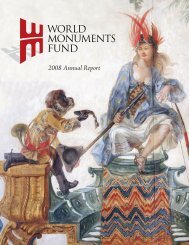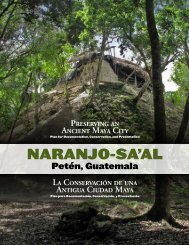Summary of the Proceedings and Papers Presented at - World ...
Summary of the Proceedings and Papers Presented at - World ...
Summary of the Proceedings and Papers Presented at - World ...
Create successful ePaper yourself
Turn your PDF publications into a flip-book with our unique Google optimized e-Paper software.
public works law as it pertains to cultural property needs<br />
reviewing. O<strong>the</strong>rs suggested looking into <strong>the</strong> possibility <strong>of</strong><br />
setting up specially trained crews to carry out routine works,<br />
although this might be complic<strong>at</strong>ed in light <strong>of</strong> Italy’s labor<br />
laws.<br />
Interpret<strong>at</strong>ion <strong>and</strong> tourism<br />
“I am afraid we are going to lose <strong>the</strong> capacity to learn history,”<br />
commented one <strong>of</strong> <strong>the</strong> archaeologists who felt reconstruction<br />
was a dangerous trend in terms <strong>of</strong> educ<strong>at</strong>ion <strong>and</strong><br />
interpret<strong>at</strong>ion. His concern was answered by a commitment<br />
not only to educ<strong>at</strong>e visitors about <strong>the</strong> history <strong>of</strong> <strong>the</strong> Romans,<br />
but to try <strong>and</strong> share <strong>the</strong> experiences <strong>of</strong> investig<strong>at</strong>ing <strong>and</strong> <strong>of</strong><br />
conserving an archaeological site. Participants discussed<br />
wh<strong>at</strong> kind <strong>of</strong> tourist comes to Pompeii, <strong>the</strong> short dur<strong>at</strong>ion<br />
<strong>of</strong> <strong>the</strong> average visit—one, maybe two hours—<strong>and</strong> most <strong>of</strong> all<br />
how many come to <strong>the</strong> site. Some 2.4 million people visit<br />
Pompeii in a year.<br />
If you have 10,000 people walking through a site on a<br />
daily basis <strong>the</strong> wear <strong>and</strong> tear has to be considerable, no m<strong>at</strong>ter<br />
how large <strong>the</strong> site. This is certainly aggrav<strong>at</strong>ed by tourists<br />
having to walk along <strong>the</strong> same few streets <strong>and</strong> visit <strong>the</strong><br />
same two or three houses, because so much <strong>of</strong> Pompeii is<br />
<strong>of</strong>f limits. The de facto ab<strong>and</strong>onment <strong>of</strong> blocks <strong>and</strong> blocks <strong>of</strong><br />
<strong>the</strong> excav<strong>at</strong>ed ancient city th<strong>at</strong> were formerly accessible is<br />
part <strong>of</strong> <strong>the</strong> vicious circle th<strong>at</strong> was <strong>the</strong> main reason for bringing<br />
toge<strong>the</strong>r <strong>the</strong> 50 archaeologists, architects, conserv<strong>at</strong>ors,<br />
found<strong>at</strong>ion administr<strong>at</strong>ors, <strong>and</strong> heritage conserv<strong>at</strong>ionists for<br />
last November’s symposium.<br />
Site management<br />
All <strong>of</strong> <strong>the</strong>se concerns, which are concerns <strong>at</strong> every major<br />
archaeological site, depend ultim<strong>at</strong>ely on good site management.<br />
Planning, maintenance, <strong>and</strong> interpret<strong>at</strong>ion are all<br />
elements <strong>of</strong> archaeological site management. The recently<br />
completed Un Piano per Pompei provides an important tool<br />
<strong>and</strong> <strong>the</strong> establishment <strong>of</strong> a planning <strong>of</strong>fice is indeed a promising<br />
start. Perhaps <strong>the</strong> gre<strong>at</strong>est need <strong>at</strong> this stage is for management<br />
guidelines.<br />
Sustainability depends on maintaining balance, <strong>and</strong> balance<br />
requires careful management <strong>and</strong> an interdisciplinary<br />
approach. The present symposium will hopefully open a dialogue<br />
<strong>and</strong> enable those concerned to view <strong>the</strong> problems <strong>of</strong><br />
Pompeii in an intern<strong>at</strong>ional context. It is increasingly clear<br />
th<strong>at</strong> caring for <strong>the</strong> world’s very large archaeological sites<br />
may to some extent need to be intern<strong>at</strong>ionalized, to mobilize<br />
intern<strong>at</strong>ional institutions, advisors <strong>and</strong> funding <strong>at</strong> many<br />
<strong>of</strong> <strong>the</strong> world’s gre<strong>at</strong> archaeological sites; certainly Pompeii,<br />
which after all was <strong>the</strong> first.<br />
The symposium’s participants drew up a “list” <strong>of</strong> <strong>the</strong> main<br />
points covered during <strong>the</strong> proceedings <strong>of</strong> <strong>the</strong> symposium,<br />
which follow in <strong>the</strong> form <strong>of</strong> 12 principles <strong>and</strong> a series <strong>of</strong> ideas<br />
for <strong>the</strong> future.
















